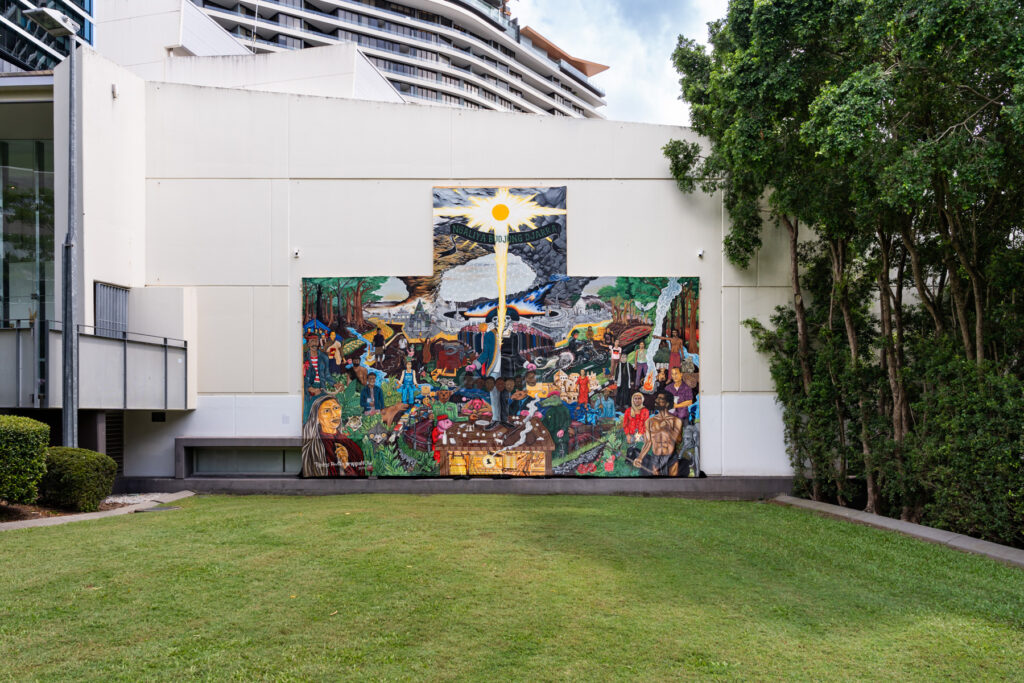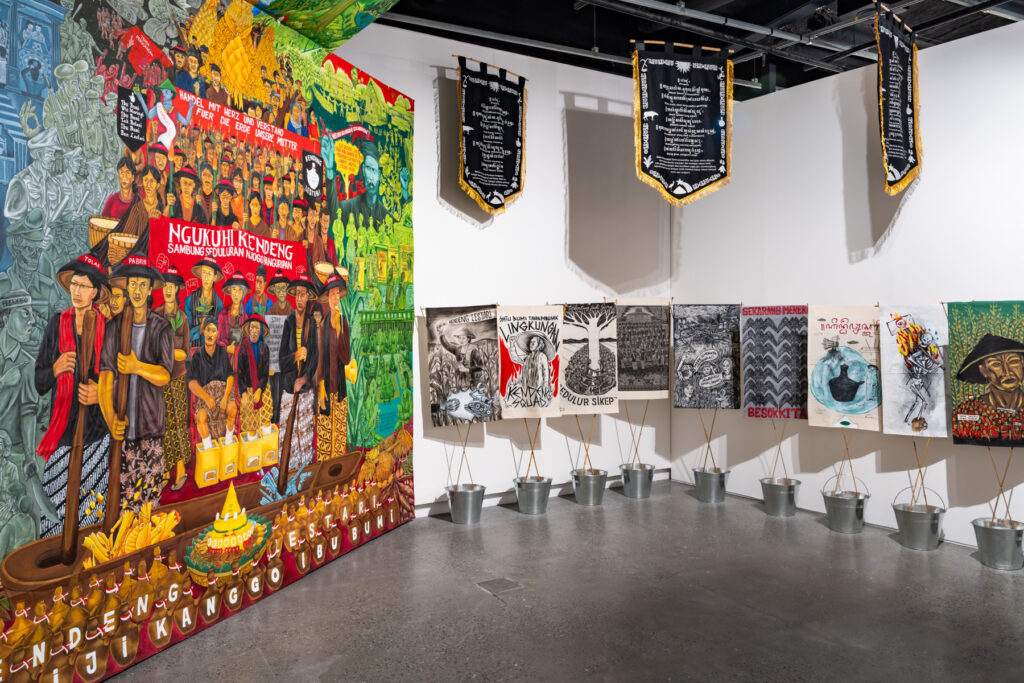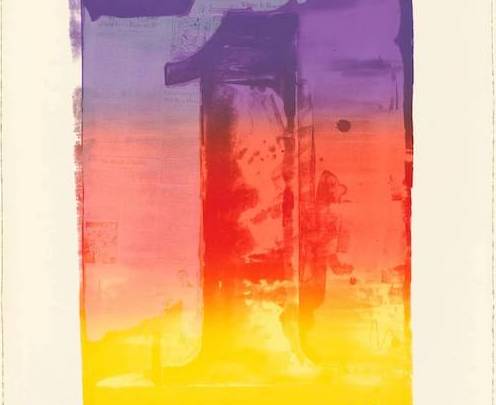
The current exhibition at Griffith University Art Museum (GUAM) is Tanah Tumpah Darah by Indonesian collective Taring Padi. I was looking forward to seeing their large-scale murals in person, arriving with some awareness that Taring Padi and Ruangrupa (another Indonesian collective who curated Documenta 15 in Kassel, Germany) were controversially accused of anti-Semitism and forced to remove work from the exhibition in 2022.[1]
On entering the installation at GUAM, I was greeted by a procession of oversized cardboard props mounted on bamboo rods. These were made locally in workshops, blending caricatures of dingoes, kangaroos, Maccas, and even a Queensland Police Badge topped by a jester’s cap. These wayfaring markers and protest props transport Taring Padi’s practice directly into the political context of suburban settler-colonial Australia. Similar props and puppets are displayed throughout the exhibition. Placed alongside Solidaritas, a series of large wall-hung woodcut prints at the museum entrance, under a massive painted canvas canopy, the viewer is surrounded by Taring Padi’s political and creative work from the past 25 years.
The potential for cultural exchange and solidarity at the core of Taring Padi’s practice is described in the introductory wall text:
At the heart of this project was an invitation to a conversation. Local Aboriginal arts collective proppaNOW invited Indonesian artsworker collective Taring Padi to come to Meeanjin/Magandjin (Brisbane) on Yuggera and Turrbal Country to collaborate during a month-long residency on the design and execution of a large-scale banner Ngaliya Budjong Djarra (Our Mother Earth) 2023–24, displayed on the western facade of the Griffith University Art Museum.
Established in 2003, proppaNOW is a major presence in contemporary arts discourse, both locally and internationally. The largely Meeanjin based collective was recently awarded the prestigious 2022–2024 Jane Lombard Prize for Art and Social Justice in New York.[2]

With proppaNOW members initiating and facilitating the residency with Taring Padi, it seemed curatorially odd to hang the most significant work from this collaboration outside on a back wall of the museum. The outside placement of the large-scale collaborative mural, Ngaliya Budjong Djarra, may have been a deliberate refusal to contain collective Aboriginal knowledge inside a university building that, as Associate Professor Fiona Foley has noted, carries a name associated with Aboriginal massacres across Queensland.[3] Or it may have been to encourage better access to the politics of the work – a public mural – for the public. In either case, the fact that the mural is ultimately hidden behind some bushes within the walls of a university campus feels counterintuitive. Like the richly detailed and integrated weaving of Aboriginal and Indonesian activist histories and academic knowledges streaming across the mural to collectively resist and infiltrate the dual threats of British and Dutch colonial violence and environmental extraction, Ngaliya Budjong Djarra, I feel, should have been better situated alongside Taring Padi’s other political works, or been part of a larger, more integrated program to place these political murals across the whole campus as a deliberate critique of the institution itself. The political richness and depth of detail in Taring Padi’s collaborative murals speak directly to the overt and covert problems of many universities. The potential for art to activate discourse, or to be situated and present as teaching aids in lectures, keynotes, and conversations around class theory, race, gender, and structural bias is obvious. It was strange that the collaborative output with proppaNOW was singled out in a public space whilst the rest of the works were squeezed in the exhibition space.

The resulting density of installing multiple major murals, cardboard puppets, posters, and banners in GUAM’s main exhibition space is ultimately unimaginative and overwhelming. With little breathing space, there is a sensation of being caught in the maelstrom of protest and activity, but one that sits largely silent, spot-lit and static. With few breaks for the viewer to absorb the significant political punctuations and achievements of the various communities and projects that Taring Padi has actively supported; including Casa do Povo and Movimento dos Trabalhadores Rurais Sem Terra (MST) from Brazil, West Papua Liberation, the Lumpur Lapindo disaster in East Java, and JK-PPK (Community Network Concerned for the Kendeng Mountains) and many others, the specificity of each of these communities, their complex stories, and concerns becomes less apparent. This has the unfortunate result of presenting the politics and actions of Taring Padi and their many collaborators as a mass collection of elsewhere people struggling with elsewhere problems. Contrary to this presentation, the recuring themes of precarious employment, extractive capitalism, corruption, and ethical divestments at the core of Taring Padi’s projects are profoundly current, relevant, and present for many university staff and student organisations struggling with job insecurity whilst pushing their employers to re-evaluate research networks with Israel and Russia in respect to the ongoing and aggressive targeting of higher education in Gaza and Ukraine.[4]
The economic restructuring of the Arts within Australian universities are impacting organisations like the Griffith University Art Museum, which shockingly faced closure in December 2023.[5] How can a university museum do the work of engaging and challenging its academic communities and publics when constantly under the threat of funding withdrawal? How can these institutions advocate for artists and staff when they too face increasing precarity, censorship, and closure?
It was a relief to discover that the mural Sekarang Mereka, Besok Kita (2021) (the work accused of being anti-Semitic and removed from Documenta 15) is currently being exhibited at GUAM.1 Following October 7th and the ongoing war on Gaza, many contemporary artists in Australia, and around the world, are also now been accused of anti-Semitism merely for supporting the Palestinian people’s right to exist freely in their own homelands.
Catching up with a few artists and asking about their response to Tanah Tumpah Darah, I learnt that the university was not willing to exhibit a mural that Taring Padi started in 2022 in Europe with a group of exiled Palestinian artists. This previously unseen mural was completed alongside Ngaliya Budjong Djarra at the Yeronga Paint Factory and could only be shown beyond the university campus. Unlike the quiet presentation of activism in a university art museum, a noisy community party to see this work, hosted by proppaNOW on Sunday 3rd of March, was probably a better representation of the depth and breadth of Taring Padi’s collaborative output. In a world where precarity proliferates in so many ways, and across so many lives and spaces, it is the collective solidarities and dialogues at the core of Taring Padi’s approach that reminds viewers of the importance of turning up, having a dance, and holding space for uncomfortable conversations, then doing what we can to reimagine the many worlds we find ourselves in.James Nguyen is an artist and researcher based in Naarm.
[1] Taring Padi collective interview.
[2] Jane Lombard prize for art and social justice recipient proppaNOW.
[3] Enabler of massacres: the push to reexamine the legacy of founding father Samuel Griffith.
[4] The war in Gaza is wiping out Palestine’s education and knowledge systems and University world news.
[5] Griffith University Art Museum faces closure and Property developer offers lifeline to Griffith gallery.
- Editor’s note 5 April 2024: Taring Padi and Griffith University Art Museum have clarified the work removed from Documenta was People’s Justice #1, not currently on show. The work currently at GUAM Sekkarang Mereka, Besok Kita was one of the murals deemed fit to be exhibited throughout Documenta. ↩︎
James Nguyen is an artist and researcher based in Naarm.



